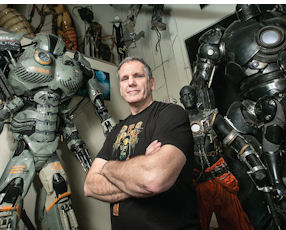The average film or television viewer may not know Legacy Effects but they are certainly familiar with its work. Inside the San Fernando company can be found suits warn by Tony Stark and other characters in the “Iron Man” franchise, the pilot gear from “Pacific Rim” and the character Destroyer from “Thor.” There’s even an animatronic duck used in AFLAC commercials, complete with real feathers. So how does the firm stay relevant in an age of digital effects? Co-founder Alan Scott said that it’s a combination of the company’s artistry and advanced technology. “Every phone call is someone looking for something that we haven’t quite done before,” said Scott. “We use our past experience and current trends of doing things to solve those problems.” There is no better example of that strategy than the seven 3-D printers that are installed in Legacy’s 25,000-square-foot building in an industrial neighborhood in the northeast San Fernando Valley city. The company, founded in 2008, has a seven-figure investment in the technology after equipment, material and training are all factored in. The first 3-D printing machine came at a cost of $250,000. A newer Connex model printer from Stratasys, of Minneapolis, cost $350,000. The printers not only can fabricate intricate models that might have been inconceivable in the past, but they do it much faster than when it was all done by hand. That gives the company an advantage in servicing movies in production. If spare parts are needed for the gloves that are part of the “Iron Man” suit, the parts can be produced quickly and sent off to the film location. “This is a big part of the workflow – to produce the things at the speed and quality we are looking for,” Scott said. Printing in 3-D is the hottest trend in manufacturing, but Scott and his three business partners became familiar with it years ago while working for special effects pioneer Stan Winston at his Van Nuys studio. After Winston passed away in 2008, Scott, John Rosengrant, Lindsay MacGowan, and Shane Mahan started Legacy, choosing the name to honor the memory of their mentor. They also decided to do all their 3-D printing in-house rather than use an outside contractor to have better control of the work. “You learn more about the process when you have to follow it all the way through,” Scott added. Printing in 3-D starts with a computer that creates a three-dimensional digital file of an object. A special printer then makes the object layer by layer, or what is called additive manufacturing, using a plastic polyvinyl chloride or other material. The red and gold suit worn by Robert Downey, Jr. in the first “Iron Man” released in 2008 was made by Stan Winston and was the first all 3-D sculpted character, Scott said. All subsequent versions in the two sequels and “The Avengers” movie in 2012 were made by Legacy. Traditionally, the suit would have begun as a clay model, but there is little time for that today, given tighter preproduction schedules. That prompted Legacy to adopt an “industrial-design” approach: The printers first make prototypes and then can produce multiple copies in the same amount of time it would have taken to make one model. “It doesn’t take away from the artistry because those parts are never finished 100 percent so they always need work on them,” Scott said. As long-time users of 3-D printing technology, Legacy has taken a role in advocating and promoting the use of the printers in the entertainment and other industries. In January, three Legacy employees spoke at the 3D Printer World Expo in Burbank. Jason Lopes, a lead systems engineer, will give a keynote address at next month’s Additive Manufacturing Users Group conference in Tucson. Legacy is a member of the group and finds itself in some tall company, including NASA and Boeing Co. in Chicago. Bret Bordner, president of the group, said Legacy is the only entertainment company that is a member and it helps illustrate the wide uses of the technology. He noted that at last year’s conference, Legacy brought along props used in “Iron Man” made with a 3-D printer. “They had the helmet and the heart that went in (Tony Stark’s) chest,” said Bordner, vice president at Laser Reproductions, a provider or rapid prototyping services in Gahanna, Ohio.
